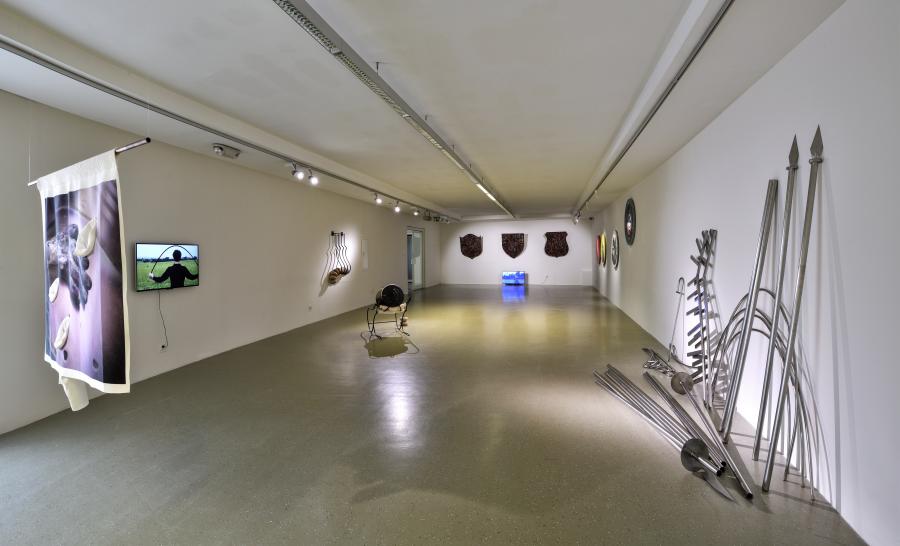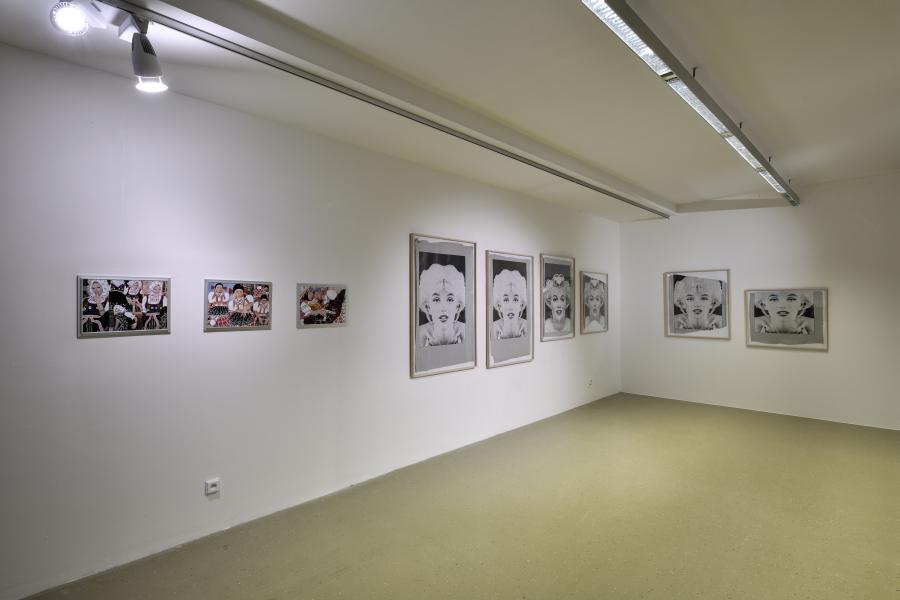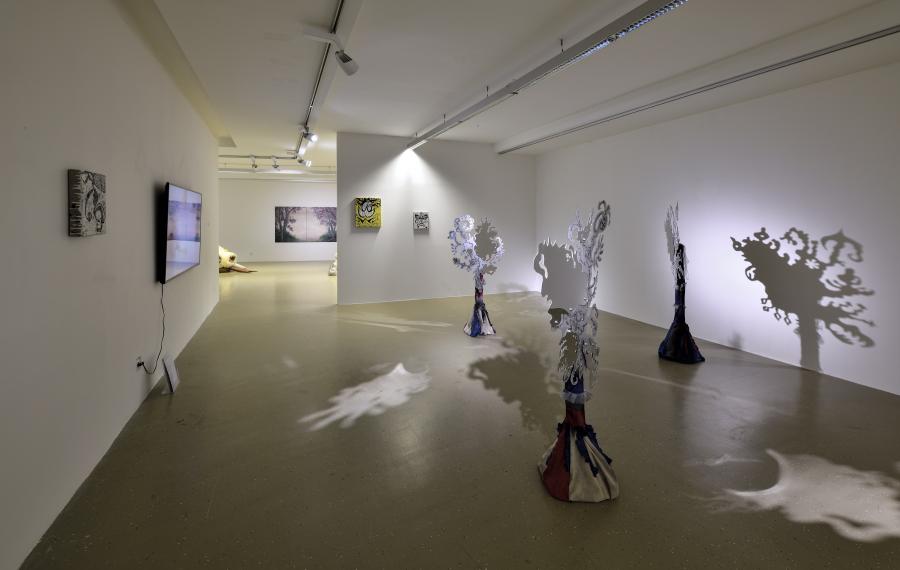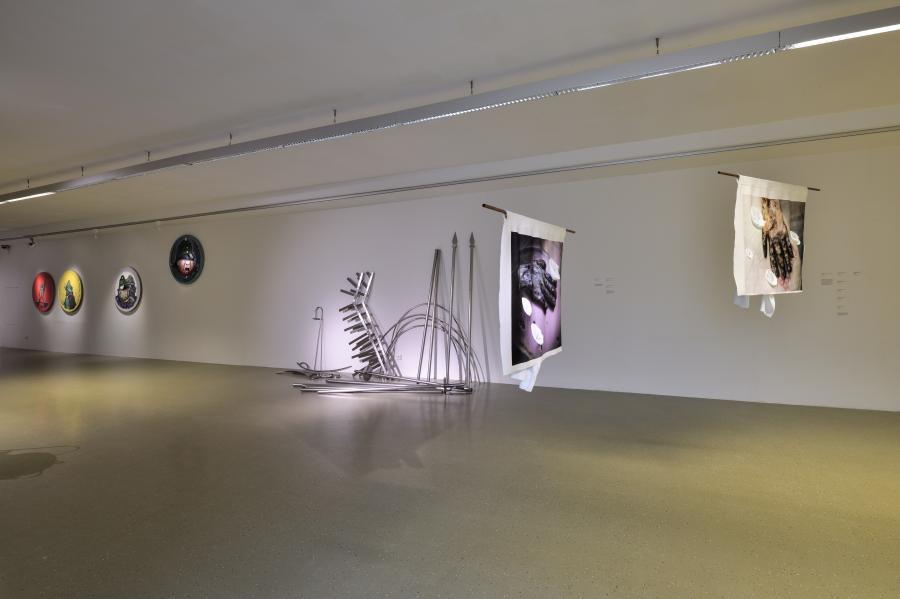Orient2
The exhibition Orient2 is a meditation on the existence of Eastern European identity. It finds as unifying aspect in this ambiguous region a contradictory but also complementary self-underestimation (0), and a simultaneous arrogance (1). These are two definitional positions of the region’s wounded identity. Suggesting that a suppressed inferiority complex is a possible reason for the recent upsurge of nationalism and non-democratic tendencies in Eastern Europe, the exhibition asks whether the failure in constituting and performing Eastern European identities, if it were accepted, could not be turned into a virtue.
This exhibition chose the obviously problematic title, a reference to Edward Said’s Orientalism (2), to underline the existence of Eastern Europe as series of projections related to lack of information and ignorance of individuals and institutions alike (3). This projection is however both-sided, Orient itself needs an Occident, as Eastern Europe requires the Western one, that is also very different from how we imagined it.
The title is however also a hyperbolic warning for Eastern Europe not to enter “oriental despotism”, to help to finally grow up and return to the European home once again. (4) Orient2 is also chronology of liberation failures, the 1980s onwards history of false feelings, that freedom had finally arrived. (5)
The stated centre-periphery dichotomy, or rather the civilised-non-civilised isn’t only a question of “manners” but mainly of money. (6) It is no more a question of access, but of infrastructure and capital accumulation. This exhibition takes a more materialistic approach towards the proclaimed autonomy of art. Context matters in what we see as good or bad art, and this context can be bought. And lack of infrastructure seen as lack of quality.
Capital is also language. (7) I will never speak and write English as I would like. But it is not only the minor languages we speak, a list of names with all these weird letter accents, but also the language of international art. That’s why people often dream to go to places they have already seen, and curators choose works, that speaks the language they understand. This exhibition aims to create this mythology of attraction. If obscurity and exoticism is part of it, so be it.
The form will be a drama that takes the viewer through five genre scenes of inglorious histories following the historical dialectics of the region’s development in the last thirty years. Genre allows us to be both serious and ironical. And that is something very Eastern European. The classical emancipatory move of appropriating our own insults.
The exhibition Orient2 is a continuation of Orient project, exhibition that opened in April 2018 in Kim?, Riga, in June 2018 in BOZAR, Brussels and in September 2018 in Bunkier Sztuki in Krakow. Although the 5 section structure of the exhibition has been kept, all the artworks and absolute majority of the artists are different.
(0) In LUX: Laura McLean Ferris: New Artist Focus: Laura McLean Ferris on Deimantas Narkevicius: “The landscape of their country – a sprawl of snowy hills and ugly roads, paints a lonely picture, and suggests that there is no one to see them.”
1 “Farewell, Poland, farewell, empty wasteland, forever covered in snow and ice (…) Barbaric people, arrogant and fickle, Braggarts, blabberers, having nothing but language, Who, day and night shut up in a heated room, Amuse themselves with a glass for every pleasure, Smore at the table and sleep on the ground.” Philippe Desportes: Adieu à la Pologne, 1574, translated from French in Philippe Desportes’s “Adieu à la Pologne” and Jan Kochanowski’s “Gallo Crocitanti” by Rory Finnin in Comparative literature studies, Vol. 44, No.4, 2007
2 Edward Said: Orientalism, compare Larry Wolff: Inventing Eastern Europe: “As late as the eve of World War I, French scholarship still alternated between two seemingly similar terms, l’Europe orientale (Eastern Europe) and l’Orient européen (the European Orient). (…) The idea of Eastern Europe was entangled with evolving Orientalism, for while Philosophic Geography casually excluded Eastern Europe from Europe, implicitly shifting it into Asia, scientific cartography seemed to contradict such fanciful construction. (…) Such uncertainty encouraged the construction of Eastern Europe as a paradox of simultaneous inclusion and exclusion, Europe, but not Europe.”
3 Lucy Steeds in How We Talk About East-European Art? conference by tranzit.sk: “There was only one Eastern European artist included in Les Magiciens de la Terre (…) We’re now gonna shift to Havanna, to consider the 3rd Art Biennale of 1989, which as you can see here, was the subject of the first of the two volumes, under the “Making Art Global” title. And I can tell you right away, that no Eastern European Artists were included, but if you look at the catalogue, no Western artists, as strictly, were represented either.”
4 this term that Václav Havel used in his speech to U.S: Congress on February 22nd 1990, was translated from the original Czech word “zbloudilé” meaning rather “abandoned”, “lost”, or “stray children” by the simultaneous interpreter as “wayward children”
5 “In November 1956, the director of Hungarian News Agency, shortly before his office was flattened by artillery fire, sent a telex to the entire world with a desperate message announcing that the Russian attack against Budapest had begun. The dispatch ended with these words: We are going to die for Hungary and for Europe.” Milan Kundera in The Tragedy of Central Europe, The New York Reviews of Books, 1984
6 in Political Critique: Eastern Europe according to British media: More likely to go to Italy for cappuccinos than join the ethnic fighting in Kosovo, Anna Azarova further writes” “Eastern Europe’s main attraction is, of course, that it’s cheap. (…) “knock-down prices, […] lured by dirt-cheap flights,” “cheap beer and even cheaper women,” (…) The inhabitants of these cheap countries who lived the painful past and its consequences were similarly hardly mentioned – except in the context of describing their excitement at the sight of westerners’ purcha$ing power; or as wild, undesirable side-effects.””
7 “Well, dearest friend, dearest Hikkitihoki, that is your name as you must know. We all invented names for ourselves on the journey. They are: I am Punkitititi. My wife is Schabla Pumfa. Hofer is Rozkapumpa. Adler is Notschopikitischibi. My servant Joseph is Sagadarata. My dog Goukeri is Schomanski. Madam Quallenberg is Runzifunzi. Mlle. Krox is Rumborimuri. Freistaetler is Gaulimauli. Be so kind as to tell him his name.” these lines to Gottfried von Jacquin, from January 1787, wrote German speaking Mozart after his journey from Vienna to predominantly German speaking Prague, through Czech speaking lands of Bohemia
Genre Scene 1: Waiting Room
“My context is a country that was built on a social and political Utopia. But I grew up in the period when nobody really believed in it. The fall of the Soviet Union was at a time when people had other Utopias. These were liberal Utopias, about freedom to do what you do. These kinds of Utopia were also an illusion, and lasted only for a few years. People grew disillusioned very quickly. What kind of Utopias can be created on a human scale? That is the question and I don’t have an answer.”
Deimantas Narkevicius: Against monumentality by Hans Ulrich Obrist, Flash Art, July – August – September 2008
Genre scene 2: All dressed up and nowhere to go
“In my cabaret there were no eight years old girls. But girls of age, girls long legged, girls – imitations of angels. Instead of wings, they spread their long legs, which was as beautiful, as if it were angel wings. Guests liked it more than any show of an illusionist, and their faces followed the open genitals with fascination, like the praying bodies of Muslims follows Mecca. To make the show more interesting, girls were making different special effects. One for example put in her vagina a blinking plastic ring with diode. When after, she got naked, spread her legs, all her c**t was lighten through visibly. And the ring was not at all visible. Then once she started to pee, it looked like the famous light fountain in Fučíkárna. (…) Another speciality were the glass eyes, used for the mutilated bodies from car crashes. The amazed “ooh” of the Germans floated in the bar, when a girl spread her legs and there was a “magic eye” looking on the amazed guests! It even winked when she alternately closed and open her legs. It was unbelievable illusion of a living eye, right in the anus. You must admit, that real angels, even with their wings, would never be able to reach that effect!”
– Ivan Jonák, from the 700 pages unpublished memoir.
“Ivan Jonák, a Czech businessman, owner of legendary club Discoland Silvia, that he once infamously promoted, riding in white day’s Prague’s city centre in open car himself naked with naked female models, who served 18 years in prison for ordering the killing of his wife in the 1990s, and who was himself subject of two failed murder attempts, has died at the age of 59, on the 666th day after his release from prison.”
Radio Prague, 24/2/2016
Genre scene 3: Carpathian Digital Meadows
“Our emotional state of choice is Ecstasy. Our nourishment of choice is Love. Our addiction of choice is technology. Our religion of choice is music.
Our currency of choice is knowledge. Our politics of choice is none. Our society of choice is utopian though we know it will never be.
You may hate us. You may dismiss us. You may misunderstand us. You may be unaware of our existence. We can only hope you do not care to judge us, because we would never judge you. We are not criminals. We are not disillusioned. We are not drug addicts. We are not naive children. We are one massive, global, tribal village that transcends man-made law, physical geography, and time itself. We are The Massive. One Massive.”
– fragment from Shockraver Manifesto
“Main field: Circus Alien, Kernel Panik, Mikro, Direct Drive, Deport, Frontall, Hypno, Morphonic, Harampade, Space patrol, Otok – Tone – Trois Points, Spectro + Virus + P.E., Saltimbank + K.G.R., R.T.G., Gardenzitty, Aphrikka, System Defekt, Tribal Vision, Layka, Full Circle, Mimic, Prior, Fatal Noise, Esc. Komatsu, Pentatomica, Tsunami, Anal Commandos, Team Trash, Kaztrol, Letek, Vosa + Emmadoom, Distix + Singular, Bass Beast D.B.S., Machine WRKS AKA, Restless Natives, Strahov, Oktekk, M2R, Shamanic, Psykomatik TPR, Ufopunkers, MayapuR, Zuqwa,
Second Field: Virvál, Magion, Master kru, Rotor, Trinidad, Hedonix + Pan:dan, Spofa, Laydakk, Recycle, Basswoos, Rekrea, Zmastek, MassaCrew, Czahovna Soundsys, Funda-Mental, IGRA 1.5V, Locus, Antares, Bione, Illegal Soundsys, Kwan, Pitel, CML, Third Hand, Mozaika, Radio 23, Cable, Haccor
NSK Field: NSK, Metek, Cabaret, Luxor, Ubik, Qwadrant soundsystem, stupid sounds
Deset Storm Field: Trakkass + Oxyde + Metro, Deset Storm + Toltek + New Sense, Hekate + Reset + Headfuk, pH:4, Enzo, D.P.”
– participating sound systems map of free tekno festival Czechtek 2004
Genre scene 4: The Devil in the Machine
“The horrific new trend was set on February 19 by a 26-year-old jobless man, who poured a flammable liquid on his half naked body and set himself on fire in front of the local branch of a major bank to the utter horror of a few passers-by.
(…)
Less than 24 hours later Bulgaria was jolted even more, when a 36-year-old artist, climber and environmentalist, set himself on fire in the center of Bulgaria’s sea capital Varna, scene of the biggest rallies of anti-government protesters in recent months.
(…)
While struggling with severe burns that had left healthy skin only on his feet the young man became known as Bulgaria’s Jan Palach, the Prague student, whose death in flames sparked the hope of a whole nation back in 1969.”
– Milena Hristova: Bulgarian Burning Bushes, novinite.com March 27th, 2013
“Andrzej Filipiak came to Warsaw from Kielce on Tuesday night. At Around 11PM he sat on the bench in front of prime ministers office and set himself on fire. He did not have any banners, he did not shout. (…) A 56-year old man could not find a job and did not receive help from the state. “He asked me 30 zł for a ticket. He just said he was going to Warsaw. He shaved and left the house,” says his wife.”
– wpolityce.pl, June 13th 2013
“Lydia Petrova, the 38 years old photographer, who set herself on fire before the building of the Presidency in Sofia last week has passed away. Despite the efforts of doctors from Pirogov emergency hospital the woman expired last night. She had extremely heavy burns and from the very beginning medics warned her state is incompatible with life. Let us remind that Lydia Petrova set herself on fire on November 3 as a sign of despair before the eyes of dozens of journalists and pedestrians around the Presidency.”
– BNR, radio Bulgaria, November 10th 2014
“Piotr Szczesny, a 54-year-old father of two, set himself on fire in front of the Communist-era Palace of Culture in Warsaw. Mr. Szczesny’s outcry was aimed against the far-right policies of the ruling Law and Justice Party, which he believed represented a mortal danger to Poland’s democracy. In a leaflet that he seems to have distributed before his suicide, he was unflinching: “I love freedom first and that is why I decided to immolate myself, and I hope that my death will shake the consciences of many people.”
Ivan Krastev, New York Times, December 2rd, 2017
Genre scene 5: Shadows of the Past Futures
“Art of Eastern Europe, if there was one and if it was to be written about by an Anglophone art historian, had to be presented according to the rules of quite another discourse, as convincingly autonomous, immunised, so to speak, against the dominant sociopolitical clichés about rape, backwardness, imitativeness, and “clean tractors”. Not surprisingly, a tentative and Cold War-underpined Western research on art in Eastern Europe focused almost exclusively on modernism behind the Iron Curtain, following the patterns of the earlier rediscovery of the persecuted Russian and Soviet avant-garde.”
Welcome to Slaka: Does Eastern (Central) European Art Exist? by Katarzyna Murawska‐Muthesius, 2006
“Coincidentally the tongue I use is one of Czechs, of Slavs, of slaves, of onetime slaves to Germans and Russians, and it’s a dog’s tongue. A clever dog knows how to survive and what price to pay for survival. He knows when to crouch and when to dodge and when to bite, it’s in his tongue. It’s a tongue that was to have been destroyed, and its time has yet to come; now it never will. Invented by versifiers, spoken by coachmen and maids, and that’s in it too, it evolved its own loops and holes and the wildness of a serpent’s young. It’s a tongue that often had to be spoken in whispers. It’s tender and cruel, and has some good old words of love, I think, it’s a swift and agile tongue, and it’s always happening. Not even the Avars could get this tongue of mine, not tanks or burning borders or the most repulsive human species of all: cowardly teachers. What will eventually get it is cash in a shrinking world. But I still have time.”
– Jáchym Topol: City Sister Silver, 1994
Michal Novotný
Exhibition curator
– – – – – – – –
MICHAL NOVOTNÝ (*1985, Prague, Czech Republic) is the Director of Modern and Contemporary art Collection at the National gallery in Prague. Between 2011 and 2018 he was the director of Centre for contemporary art Futura in Prague, also from 2016 to 2018 he was the curator at large at Plato Ostrava. He is teaching at Academy of Arts, Architecture and Design in Prague, where he is an assistant professor since 2016. In 2018 he prepared curatorial projects for the Passerelle Centre for Contemporary Art in Brest, together with Jiří Kovanda, a site-specific project for the Black Cube Art Museum in Denver, and with Anna Daučíková the exhibition at the State of Concept in Athens. The two-year curatorial project under the title Orient. Meditation on the Eastern European Identity, featured 45 artists and traveled to the Contemporary Art Centre in Riga, BOZAR in Brussels, and Bunkier Sztuki in Krakow. In November 2018 he has opened a group exhibition at Art in General in New York. He participated in residential and research programmes at the Delfina Foundation in London (2016), Contemporary Arts Center in New Orleans (2014), Contemporary Art Museum in Rijeka (2014), Design Cloud in Chicago (2014), Villa Arson in Nice (2013), and Independent Curators International in New York (2011).
– – – – –




















